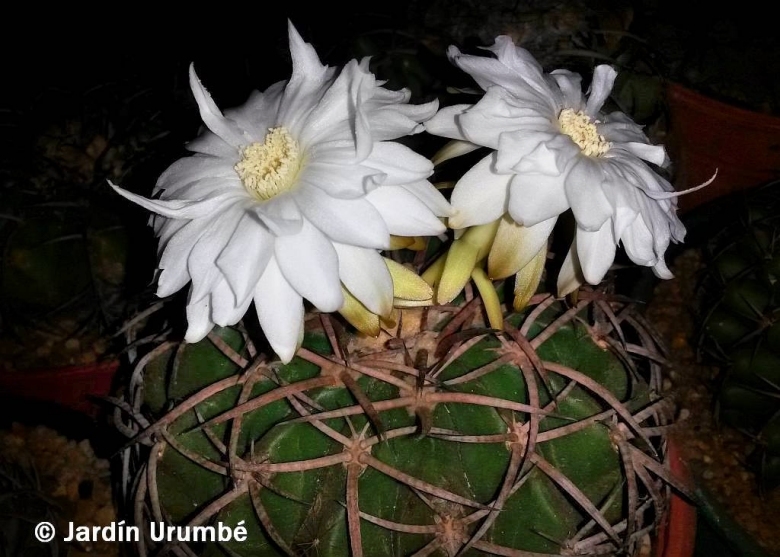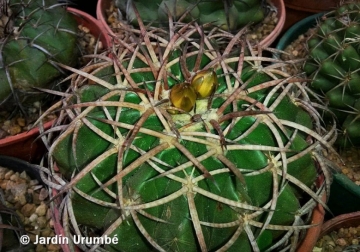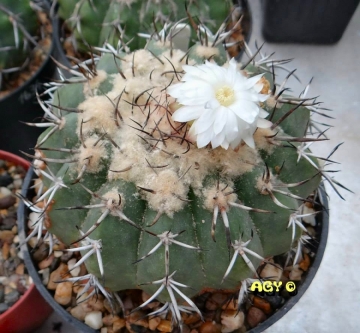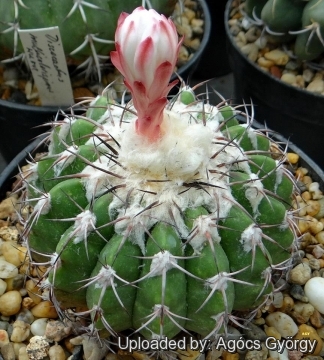Accepted Scientific Name: Discocactus placentiformis (Lehm.) K.Schum.
Nat. Pflanzenfam. Nachtr. [Engler & Prantl] iii. 6 a. (1894) 190.

Discocactus multicolorispinus Photo by: Alexander Arzberger
Origin and Habitat: Conselheiro Mata, Barao de Quacuy, and Datas, at the border of the Serra do Espinhaco in Minas Gerais. Brasil.
Altitude range: Around 1000 metres above sea level.
Synonyms:
See all synonyms of Discocactus placentiformis
back
Accepted name in llifle Database:Discocactus placentiformis (Lehm.) K.Schum.Nat. Pflanzenfam. Nachtr. [Engler & Prantl] iii. 6 a. (1894) 190.Synonymy: 26
back
Description: Discocactus multicolorispinusSN|1442]]SN|1442]] is clearly another geographical form of Discocactus placentiformisSN|1430]]SN|1430]] (Lehm.) Schumann, a species first described in 1826! Discocactus placentiformisSN|1430]]SN|1430]] is a variable species that comprises several questionable varieties and its taxonomic history has undergone several changes. The differences usually concern the spination, however the colouring, size and density of spines is influenced by the conditions of culture, at lower light levels the spines are less numerous, delicate, while with strong solar radiation the spines are stronger with a darker tint. Minor differences can also be found in the colour of stems, ribs, cephalia and flowers. Discocactus multicolorispinusSN|1442]]SN|1442]] is distinguishable for the spines mostly amber like, but variable in colouration (multicolored) hence the name.
Stems: Flattened-globular, less than 8 cm tall and about 12 cm in diameter dark green green, with woolly cephalium.
Ribs: About 13. Number of areoles per rib is around 10 on plants with cephalium.
Areoles: Round.
radial spines: 5 to 8 of which the 2(-4) upper ones shorter pointing upwards about 5 mm long. The length of the spines on the sides and downwards is about 1.5 cm. Mostly amber like, but variable in colouration.
Central spines: In some plants one central spine appears, but is usually absent. It is erect, 1,5-2 cm long.
Cephalium: Cream-white.
Flowers: Nocturnal lasting only a single night, and rapidly collapsing into mush the next morning, extremely fragrant, slender funnelform, white arising from the cephalium. The position of the stigma is half-way up the stamens.
Blooming season: Summer, it needs a good exposure to with some sun to bloom, so it's pretty rare to have blossoms when in cultivation in greenhouses. It is not unusual for this Melocactus to take 7 or more years before it starts blooming, but once it does, it should every year. Grafted plants may flower in 3 years.
Fruit: Club shaped white.
Subspecies, varieties, forms and cultivars of plants belonging to the Discocactus placentiformis group
 Discocactus crystallophilus Diers & Esteves: has (3)5-7 brown-reddish to pale grey spines, lateral to 2 cm long, lowermost one to 3 cm long. Uppermost about 5 mm long. Distribution: Minas Gerais.
Discocactus crystallophilus Diers & Esteves: has (3)5-7 brown-reddish to pale grey spines, lateral to 2 cm long, lowermost one to 3 cm long. Uppermost about 5 mm long. Distribution: Minas Gerais.  Discocactus insignis Pfeiff.: has 5 to 7 spines of which the lowest one more long and recurved backwards to the plant. Distribution: neighbourhood of Grao Mogol, Minas Gerais, Brazil.
Discocactus insignis Pfeiff.: has 5 to 7 spines of which the lowest one more long and recurved backwards to the plant. Distribution: neighbourhood of Grao Mogol, Minas Gerais, Brazil. Discocactus latispinus Buining ex Bredero ex J.Theun.: has 5 spines of which the lowest one more long and characteristically flattened. distribution: Joaquim Felicio and adjacent areas, Minas Gerais.
Discocactus latispinus Buining ex Bredero ex J.Theun.: has 5 spines of which the lowest one more long and characteristically flattened. distribution: Joaquim Felicio and adjacent areas, Minas Gerais. Discocactus multicolorispinus P.J.Braun & Bredero: spines mostly amber like, but variable in colouration (multicolored) hence the name. Distribution: Serra do Espinhaco in Minas Gerais. Brasil.
Discocactus multicolorispinus P.J.Braun & Bredero: spines mostly amber like, but variable in colouration (multicolored) hence the name. Distribution: Serra do Espinhaco in Minas Gerais. Brasil. Discocactus placentiformis (Lehm.) K.Schum.: is a small flattish globular cactus, with woolly cephalium. It is one of the most widely distributed and variable species. Distribution: whidespread in Minas Gerais.
Discocactus placentiformis (Lehm.) K.Schum.: is a small flattish globular cactus, with woolly cephalium. It is one of the most widely distributed and variable species. Distribution: whidespread in Minas Gerais. Discocactus placentiformis var. minor-horridulus n.n.: has smaller stems, with 5(-7) spines of which the lowest one more long and flattened. Flower often pink in the exterior. Distribution: Diamantina, Minas Gerais, Brazil.
Discocactus placentiformis var. minor-horridulus n.n.: has smaller stems, with 5(-7) spines of which the lowest one more long and flattened. Flower often pink in the exterior. Distribution: Diamantina, Minas Gerais, Brazil. Discocactus pulvinicapitatus Buining & Bredero: is very similar to Discocactus latispinus, but is larger size and has a larger cephalium. Distribution: Central part of Minas Gerais, Brazil.
Discocactus pulvinicapitatus Buining & Bredero: is very similar to Discocactus latispinus, but is larger size and has a larger cephalium. Distribution: Central part of Minas Gerais, Brazil. Discocactus tricornis Monv. ex Pfeiff.: has 3 radial spines pointing downward, occasionally accompanied by 2-3 very short spines pointing upward. (same as Discocactus alteolens?). Distribution. Eastern central Brazil.
Discocactus tricornis Monv. ex Pfeiff.: has 3 radial spines pointing downward, occasionally accompanied by 2-3 very short spines pointing upward. (same as Discocactus alteolens?). Distribution. Eastern central Brazil.
Bibliography: Major references and further lectures.
1) Cactus and Succulent Journal of Great Britain, Volume 44 Cactus and Succulent Society of Great Britain, 1982
2) Kakteen und andere Sukkulenten 1979 nr. 3 page 59
3) BRAUN, P.J.; BREDEROO, A. 1981. “D. multicolorispinus Braun et Brederoo.” Kakteen und andere Sukkulenten 16(4): 76-78.
 Discocactus multicolorispinus Photo by: Alexander Arzberger
Discocactus multicolorispinus Photo by: Alexander Arzberger - Field number HU542 (Collector Leopoldo Horst) 1 km from Conselheiro Mata, Minas Gerais, Brazil. Photo by: Agócs György
- Field number HU542 (Collector Leopoldo Horst) 1 km from Conselheiro Mata, Minas Gerais, Brazil. Photo by: Agócs György Discocactus multicolorispinus Photo by: Agócs György
Discocactus multicolorispinus Photo by: Agócs György Discocactus multicolorispinus HU 542 Photo by: Agócs György
Discocactus multicolorispinus HU 542 Photo by: Agócs GyörgyCultivation and Propagation: Discocactus multicolorispinus is not the easiest plant to keep happy, so it isn't a plants for beginners, in fact collectors consider the Discocactus to be rarities which requires skilful cultivation. Under glass, it isn't difficult, but appreciates milder winter temperatures and more generous summer watering than most of the other genera of compact cacti. When grown to maturity, however, it possess an exotic look shared by no other cacti, and it generally attract a lot of attention.
Growing rate: It is slow growing.
Soil: It likes very porous standard cactus mix soil. Prefer a low pH compost, avoid substrata rich in limestone; otherwise growth will stop altogether.
Repotting: They generally resent being repotted and can take a long time to establish.
Fertilization: Feed with a high potassium fertilizer in summer.
Exposition: The plant tolerates bright situations but enjoys filtered sunlight or afternoon shade, inside it needs bright light, and some direct sun. Tends to bronze in strong light, which encourages flowering and heavy spine production.
Waterings: Discocacti are very rot prone when kept on their own roots and though they can’t endure long stretches of total dryness, too much water with cool will rot them, as their weak root systems tend to be inefficient at sucking up water from wet soil.
Hardiness: It is rather difficult to grow and frost tender, it can’t stand cold, or even fairly cool temperatures and should be kept at above 15° C if grown on its own roots (8°C if grafted).
Uses: It is an excellent plant for container growing. It always looks good and stays small.
Pests & diseases: It may be attractive to a variety of pests or diseases:
- Red spiders: Red spiders may be effectively rubbed up by watering the plants from above.
- Mealy bugs: Mealy bugs occasionally develop aerial into the new growth among the wool with disfiguring results, but the worst types develop underground on the roots and are invisible except by their effects.
- Scales: Scales are rarely a problem.
- Rot: Rot it is only a minor problem with cacti if the plants are watered and “aired” correctly. If they are not, fungicides won't help all that much.
Propagation: Seeds or grafting. Seeds germinate in 7-14 days at 21-27° C in spring, remove gradually the glass cover as soon the plants will be well rooted (ca 1-2 weeks) and keep ventilated, no full sun for young plants! .Young seedlings are often grafted on a low stock to keep the plant in a good shape.














